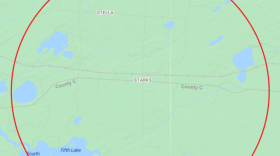People on private wells in five Oneida County Townships may be offered free PFAS testing. It stems from the contamination in the Town of Stella.
PFAS are a group of manmade chemicals that have been linked to some adverse health effects.
Town of Stella Contamination
The DNR has tested 241 wells in the Town of Stella where some of the highest levels of PFAS contamination in drinking water in the country has been found.
As of June 20, 2025, 88 private wells reported concentrations of PFAS higher than the DHS recommended guidelines. Another 39 have PFAS contamination, but below the state guideline. 114 had no detectable PFAS contamination.

No official cause of the contamination has been found, though there has been a focus on land-spreading on the agricultural fields.
An EPA report found that PFAS in biosolids that are spread on agricultural fields pose a human health and environmental risk.
In January 2024, the Oneida County Board passed an advisory resolution calling for testing of private wells within a six-mile radius anywhere in the county where biosolids have been spread.
Now, the DNR along with the EPA is offering free PFAS sampling to full-time and seasonal residents in certain townships.
Expanded testing
The testing will be concentrated on wells near or down gradient of agricultural fields in Crescent, Newbold, Pelican, Sugar Camp, and Pine Lake.
DNR Drinking Water Supervisor for Northern Wisconsin Mark Pauli says their testing of wells in the Stella area showed that PFAS contamination tended to be greater in areas around agricultural fields.
“This whole effort is to try to protect public health, and so this is just trying to see if we have any issue in other areas of Oneida County that we have seen in the Town of Stella,” said Pauli.
Pauli said they don’t have enough funding to offer free testing to all the private wells called for under the resolution by Oneida County. As WXPR mapped out, that would be most of the county.
“There's a lot of private wells, large clusters, high concentrations of private wells in all of these townships,” said Pauli. “[The testing] is limited because of the funding that we have available at this time to us.”
People that are eligible will get a letter from the DNR.
Fifty letters went out in the first round. Pauli says the goal is to send out more every three weeks or so over the next several months. This is so testing labs don’t get overwhelmed with the number of tests.
Pauli says its hard to determine how many wells they’ll be able to test with the EPA funding. If a test comes back positive, it costs more to test again to confirm. He’s hoping they’ll be able to test between 400 to 450.
“I, again, just reiterate that this right now appears to be a one-time opportunity,” said Pauli. “If they are concerned about PFAS and exposure to PFAS, I think that they should take this opportunity.”
Those who choose to participate in this sampling effort will receive their private well’s sample results and, if appropriate, recommendations from the DNR for actions to take. Pauli says if the levels come back above the DHS recommended guidelines, people will be offered emergency temporary water.
“There are some advantages for them to know for their health, whether they have PFAS impacts, and then the DNR will do whatever tools we have necessary to try to provide assistance to them,” said Pauli.
Sampling of private wells in these townships will begin in July 2025 and will likely run through December 2025.
Well owners can submit questions to DNRDGOneidaCountyPFAS@wisconsin.gov or 1-888-626-0605.
PFAS, per- and polyfluoroalkyl substances, are a group of human-made chemicals used for decades in numerous products, including non-stick cookware, fast food wrappers, stain-resistant sprays and certain types of firefighting foam. These contaminants have made their way into the environment in a variety of ways, including spills of PFAS-containing materials, discharges of PFAS-containing wastewater to treatment plants, and use of certain types of firefighting foams.










